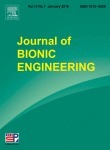Journal
Please choose volume & issue:
-
Damping of Pressure Pulsations in Mobile Hydraulic Applications by the Use of Closed Cell Cellular Rubbers Integrated into a Vane Pump
Abstracts:The present study evaluates the potential of a bio-inspired pulsation damper in a vane pump used in mobile hydraulic applications. Pressure pulsations caused by such positive displacement pumps can lead to malfunctions and noise in a hydraulic system. A common measure to reduce pressure pulsations is the integration of pressure pulsation dampers downstream of the pump. This type of damping measure can also be found in biology as
e.g. in the human blood circulatory system. Such working principles found in living organisms offer a high potential for a biomimetic transfer into technical applications. The newly developed bio-inspired damper consists of cellular rubbers with non-linear viscoelastic material properties. In order to evaluate the new damping method, pressure pulsations were measured at two different back pressures and at a wide engine speed range of the vane pump. For further assessment, different setups, varying the stiffness of the cellular rubber materials and the damper volume, were tested. Within the tested back pressures, the pressure pulsations could be reduced by up to 40%. The developed integrated pulsation damper offers a high potential to dampen pressure pulsations of positive displacement pumps used in mobile hydraulic applications operating below 10 bar. -
Wood Plastic Composites Prepared from Biodegradable Poly(butylene succinate) and Burma Padauk Sawdust (Pterocarpus macrocarpus): Water Absorption Kinetics and Sunlight Exposure Investigations
Abstracts:Wood plastic biocomposites of biodegradable poly (butylene succinate) (PBS) and Padauk sawdust was successfully prepared by using a twin screw extruder and an injection molding machine. The effects of water absorption and sunlight exposure on some properties of the composites were investigated. Water absorption of PBS composites was found to follow the Fick's law of diffusion, while the diffusion coefficient increased with increasing wood content. Maximum water absorption of around 4.5% was observed at 30 wt.% sawdust. Optical micrograph indicated the swelling of wood particles by around 1% − 3% after 30 days of water immersion. The tensile and flexural strengths reduced slightly both under the water immersion and sunlight exposure. After 90 days of exposure, the composites clearly looked paler than the non-weathered ones. Thermal scan indicated the reduction of crystalline region due to the plasticization effect derived from water molecules.
-
Experimental and Numerical Study of Penguin Mode Flapping Foil Propulsion System for Ships
Abstracts:The use of biomimetic tandem flapping foils for ships and underwater vehicles is considered as a unique and interesting concept in the area of marine propulsion. The flapping wings can be used as a thrust producing, stabilizer and control devices which has both propulsion and maneuvering applications for marine vehicles. In the present study, the hydrodynamic performance of a pair of flexible flapping foils resembling penguin flippers is studied. A ship model of 3 m in length is fitted with a pair of counter flapping foils at its bottom mid-ship region. Model tests are carried out in a towing tank to estimate the propulsive performance of flapping foils in bollard and self propulsion modes. The same tests are performed in a numerical environment using a Computational Fluid Dynamics (CFD) software. The numerical and experimental results show reasonably good agreement in both bollard pull and self propulsion trials. The numerical studies are carried out on flexible flapping hydrofoil in unsteady conditions using moving unstructured grids. The efficiency and force coefficients of the flexible flapping foils are determined and presented as a function of Strouhal number.
-
Research on Location Characteristics and Algorithms based on Frequency Domain for a 2D Underwater Active Electrolocation Positioning System
Abstracts:Weakly electric fish has an ability to generate a low-frequency electric field actively to locate the surrounding object in complete darkness by sensing the change of the electric field. This ability is called active electrolocation. In this paper, we designed a two-dimensional (2D) experimental platform of underwater active electrolocation system by simulating weakly electric fish. On the platform, location characteristics based on frequency domain were investigated. Results indicated that surface shape of 3D location characteristic curves for the 2D underwater active electrolocation positioning system was convex upwards or concave down which was influenced by the material of probed objects and the frequency of the electric field excitation signal. Experiments also confirmed that the amplitude of the electric field excitation signal and the size of the probed object will only influence the amplitude corresponding to 3D location characteristic curves. Based on above location characteristics, we present three location algorithms including Cross Location Algorithm (CLA), Stochastic Location Algorithm (SLA) and Particle Swarm Optimization (PSO) location algorithm in frequency domain and achieved the task of the underwater positioning system. Our work may have reference value for underwater detection study.
-
Comparison of Aerodynamic Forces and Moments Calculated by Three-dimensional Unsteady Blade Element Theory and Computational Fluid Dynamics
Abstracts:In previous work, we modified blade element theory by implementing three-dimensional wing kinematics and modeled the unsteady aerodynamic effects by adding the added mass and rotational forces. This method is referred to as Unsteady Blade Element Theory (UBET). A comparison between UBET and Computational Fluid Dynamics (CFD) for flapping wings with high flapping frequencies (>30 Hz) could not be found in literature survey. In this paper, UBET that considers the movement of pressure center in pitching-moment estimation was validated using the CFD method. We investigated three three-dimensional (3D) wing kinematics that produce negative, zero, and positive aerodynamic pitching moments. For all cases, the instantaneous aerodynamic forces and pitching moments estimated via UBET and CFD showed similar trends. The differences in average vertical forces and pitching moments about the center of gravity were about 10% and 12%, respectively. Therefore, UBET is proven to reasonably estimate the aerodynamic forces and pitching moment for flight dynamic study of FW-MAV. However, the differences in average wing drags and pitching moments about the feather axis were more than 20%. Since study of aerodynamic power requires reasonable estimation of wing drag and pitching moment about the feather axis, UBET needs further improvement for higher accuracy.
-
The Role of Soft Vein Joints in Dragonfly Flight
Abstracts:Dragonflies are excellent flyers among insects and their flight ability is closely related to the architecture and material properties of their wings. The veins are main structure components of a dragonfly wing, which are found to be connected by resilin with high elasticity at some joints. A three-dimensional (3D) finite element model of dragonfly wing considering the soft vein joints is developed, with some simplifications. Passive deformation under aerodynamic loads and active flapping motion of the wing are both studied. The functions of soft vein joints in dragonfly flight are concluded. In passive deformation, the chordwise flexibility is improved by soft vein joints and the wing is cambered under loads, increasing the action area with air. In active flapping, the wing rigidity in spanwise direction is maintained to achieve the required amplitude. As a result, both the passive deformation and the active control of flapping work well in dragonfly flight. The present study may also inspire the design of biomimetic Flapping Micro Air Vehicles (FMAVs).
-
Automated Kinematics Measurement and Aerodynamics of a Bioinspired Flapping Rotary Wing
Abstracts:A physical model for a micro air vehicle with Flapping Rotary Wings (FRW) is investigated by measuring the wing kinematics in trim conditions and computing the corresponding aerodynamic force using computational fluid dynamics. In order to capture the motion image and reconstruct the positions and orientations of the wing, the photogrammetric method is adopted and a method for automated recognition of the marked points is developed. The characteristics of the realistic wing kinematics are presented. The results show that the non-dimensional rotating speed is a linear function of non-dimensional flapping frequency regardless of the initial angles of attack. Moreover, the effects of wing kinematics on aerodynamic force production and the underlying mechanism are analyzed. The results show that the wing passive pitching caused by elastic deformation can significantly enhance lift production. The Strouhal number of the FRW is much higher than that of general flapping wings, indicating the stronger unsteadiness of flows in FRW.
-
Effect of Flexible Spine Motion on Energy Efficiency in Quadruped Running
Abstracts:Energy efficiency is important in the performance of quadruped robots and mammals. Flexible spine motion generally exists in quadruped mammals. This paper mainly explores the effect of flexible spinal motion on energy efficiency. Firstly, a planar simplified model of the quadruped robot with flexible spine motion is introduced and two simulation experiments are carried out. The results of simulation experiments demonstrate that both spine motion and spinal flexibility can indeed increase energy efficiency, and the curve of energy efficiency change along with spinal stiffness is acquired. So, in order to obtain higher energy efficiency, quadruped robots should have flexible spine motion. In a certain speed, there is an optimal spinal stiffness which can make energy efficiency to be the best. Secondly, a planar quadruped robot with flexible spine motion is designed and the conclusions drawn in the two simulation experiments are verified. Lastly, the third simulation experiment is carried out to explore the relationship between the optimal spinal stiffness, speed and total mass. The optimal spinal stiffness increases with both speed and total mass, which has important guiding significance for adjusting the spinal stiffness of quadruped robots to make them reach the best energy efficiency.
-
Simulation Architecture for Modelling Interaction Between User and Elbow-articulated Exoskeleton
Abstracts:The aim of our work is to improve the existing user-exoskeleton models by introducing a simulation architecture that can simulate its dynamic interaction, thereby altering the initial motion of the user. A simulation architecture is developed that uses the musculoskeletal models from OpenSim, and that implements an exoskeleton control algorithm and human response model in Matlab. The musculoskeletal models need to be extended with the response of a user to external forces to simulate the dynamic interaction. A set of experiments was performed to fit this response model. A validation test showed that more than 80% of the variance of the motion could be explained. With the human response model in the combined simulation architecture, a simulation in which an object connects with the exoskeleton or with the human is performed. The effect of the exoskeleton on, among others, muscle excitation and altered motion can be assessed with this architecture. Our work can be used to better predict the effect an exoskeleton has on the user.
-
A Case Study of a Force-myography Controlled Bionic Hand Mitigating Limb Position Effect
Abstracts:Force Myography (FMG), which monitors pressure or radial deformation of a limb, has recently been proposed as a potential alternative for naturally controlling bionic robotic prostheses. This paper presents an exploratory case study aimed at evaluating how FMG behaves when a person with amputation uses a hand prosthetic prototype. One volunteer (transradial amputation) participated in this study, which investigated two experimental cases: static and dynamic. The static case considered forearm muscle contractions in a fixed elbow and shoulder positions whereas the dynamic case included movements of the elbow and shoulder. When considering eleven different hand grips, static data showed an accuracy over 99%, and dynamic data over 86% (within-trial analysis). The across-trial analysis, that takes into account multiple trials in the same data collection set, showed a meaningful accuracy respectively of 81% and 75% only for the reduced six grips setup. While further research is needed to increase these accuracies, the obtained results provided initial evidence that this technology could represent an interesting alternative that is worth exploring for controlling prosthesis.
Hot Journals
- Risk Breakdown Matrix for Risk-Based Inspection of Transportation Infrastructure Projects
- Social Control in Outsourced Architectural and Engineering Design Consulting Projects: Behavioral Consequences and Motivational Mechanism
- 2022 Best Paper Award
- Hold-Ups and Failures in Negotiated Order: Unearthing the Nuances of Rework Causation in Construction
- Prevalence and Risk Factors for Poor Mental Health and Suicidal Ideation in the Nigerian Construction Industry
- CFRP–Cable-Stayed Bridge Hybrid with Partial Suspension and a Span Exceeding 3,000 m: Concept, Optimization, and Construction
- Impact of Wind Load Characteristics on Computed Bridge Stay-Cable Forces Used for Bridge Health Monitoring
- Weak-End and Frequency Detection of Elastically Supported Bridges by Contact Residual Response of Two-Axle Test Vehicle in a Round Trip
- Development of Performance-Based Fragility Curves of Coastal Bridges Subjected to Extreme Wave-Induced Loads
- An Analytical Model to Evaluate Short- and Long-Term Performances of Post-Tensioned Concrete Box-Girder Bridges Rehabilitated by an Ultrahigh-Performance Concrete Overlay
- Three-Dimensional Velocity Distribution in Straight Smooth Channels Modeled by Modified Log-Law
- Experimental Investigation on Flow Past Two and Three Side-by-Side Inclined Cylinders
- An Experimental Investigation of Rotor–Box Aerodynamic Interaction 1
- Modeling Gas–Liquid Flow Between Rotating and Nonrotating Annular Disks
- Entry Length Requirements for Two- and Three-Dimensional Laminar Couette–Poiseuille Flows
Advanced Materials (3,745)
- Structured Perovskite Light Absorbers for Efficient and Stable Photovoltaics
- Strategies for High‐Performance Solid‐State Triplet–Triplet‐Annihilation‐Based Photon Upconversion
- Atomic Engineering Catalyzed MnO2 Electrolysis Kinetics for a Hybrid Aqueous Battery with High Power and Energy Density
- Crystal Adaptronics: Global Performance Indices for Dynamic Crystals as Organic Thermal Actuators (Adv. Mater. 20/2020)
- Enlightening Materials with Photoswitches
Acta Astronautica (1,768)
- Mixed-integer trajectory optimization with no-fly zone constraints for a hypersonic vehicle
- Adaptive control design for active Pogo suppression of large strap-on liquid launch vehicles
- Machine learning based approach for modeling and forecasting of GPS–TEC during diverse solar phase periods
- Effect of two-dimensional micro-cavity surface on hypersonic boundary layer
- Investigation on burning behaviors of aluminum agglomerates in solid rocket motor with detailed combustion model








 User Center
User Center My Training Class
My Training Class Feedback
Feedback





